Optimizing Reserve Decisions in Relief Supply Chains with a Blockchain-Supported Second-Hand E-Commerce Platform
Abstract
:1. Introduction
- (1)
- How can the optimal reserve quantity of the government’s advance physical pre-positioning in the “second-hand E-commerce platform” consignment strategy be determined considering blockchain?
- (2)
- How can we utilize the profit function of the “second-hand E-commerce platform” to explore the key conditions for supply chain coordination?
- (3)
- What is the impact of blockchain technology and second-hand E-commerce platform transaction characteristics on the government’s optimal reserve decision?
2. Literature Review
2.1. Relief Supplies Supply Chain
2.2. Rotation of Perishable Supplies on Second-Hand E-Commerce Platforms
2.3. The Adoption of Blockchain Technology
3. Model Description and Assumption
3.1. Problem Description
3.2. Decision Sequence
- (1)
- The government will first stockpile the supplies in advance and set a rotation cycle. The parameter for the urgency of the materiel is , and the parameter for the ease of stockpiling is .
- (2)
- When the single-cycle stockpile period arrives, the government needs to rotate and renew the supplies:First, when no disaster occurs during the reserve period, the government can choose the blockchain “second-hand platform” to consign the supplies for rotation, and the supplies that are sold successfully will gain revenue, while those that fail will be disposed of at salvage value, and brand-new supplies will be purchased to make up for the shortfall.
- (3)
- When a disaster event occurs during the stockpile cycle T, the rotation of relief supplies follows the change in demand for supplies:
- If , i.e., the demand for emergency supplies is less than the government’s physical stockpile. This is similar to a no-disaster scenario, but the base number of supplies that need to be replaced is .
- If , surplus goods need to be purchased on the spot, in the order of preference to the agreed enterprise, and when the agreed company is unable to meet it, the market is used to purchase it, incurring the cost of losses due to the demand not met by the fixed channels (own reserves and the agreed company). Figure 2 illustrates the logical structure of the model.
3.3. Assumption
- (1)
- (2)
- During the procurement phase of the physical pre-positioning, which consists of a single-cycle procurement contract between the government (the purchaser of relief supplies) and the enterprise (the supplier of relief supplies). There are two main bodies, the government and the “second-hand platform”, in the rotation of supplies.
- (3)
- Utilizing blockchain timestamp technology to improve the traceability of supplies will significantly increase the efficiency and profitability of the government’s consignment of used supplies through second-hand platforms. Blockchain technology can reduce information asymmetry in the circulation of materials and increase the trust of buyers, thus improving the success rate and price of the sale of used goods.
- (4)
- Based on the logical requirements, consignment prices on second-hand platforms are less than the market purchase price of the supplies, .
4. Reserve Model for Rotation on Blockchain-Enabled Second-Hand Platforms
4.1. Government Decision Model
4.1.1. Government Cost Function in the Absence of Disasters
4.1.2. Government Cost Function in the Event of a Disaster
- (1)
- If , i.e., the demand for relief supplies is less than the government’s physical stockpile, the government’s cost function is:Under the constraint on the demand for emergency supplies, rotational quantities of supplies are those remaining in the physical stockpile and those that have not been utilized, . By simplification, the above equation can be written as:
- (2)
- If , i.e., the government’s physical stockpile of goods is less than the demand for emergency goods, . At this point, the surplus goods need to be purchased off the shelf and incur a cost of loss due to the demand not met by the physical stockpile (own stockpile). The government cost is expressed as:Since the stockpile is fully utilized and there is no rotation involved, the government’s cost function in condition keeps the same structure, which simplifies to:Based on the above profit analysis, under the probability, , of a disaster occurring during the protocol period, the government cost function for the blockchain’s “second-hand platform” consignment rotation strategy is as follows:
- (3)
- Analysis of results
4.2. Profit Function of Second-Hand Platforms
4.2.1. Profit Function of the Second-Hand Platform in the Absence of Disasters
4.2.2. Profit Function of the Second-Hand Platform in the Event of a Disaster
4.3. Model of Supply Chain Coordination
4.3.1. Profit Model for Supply Chain Coordination
4.3.2. Analysis of Model Results
5. Numerical Examples
5.1. Parameter Settings
5.2. Optimal Decision and Sensitivity Analysis for Second-Hand Platform Consignment
6. Conclusions and Future Works
6.1. Conclusions
6.2. Limitations and Future Directions
Author Contributions
Funding
Institutional Review Board Statement
Informed Consent Statement
Data Availability Statement
Acknowledgments
Conflicts of Interest
References
- Liu, Y.; Tian, J.; Feng, G.Z. Pre-positioning strategies for relief supplies in a relief supply chain. J. Oper. Res. Soc. 2022, 73, 1457–1473. [Google Scholar] [CrossRef]
- Acar, M.; Kaya, O. Dynamic inventory decisions for humanitarian aid materials considering budget limitations. Socio-Econ. Plan. Sci. 2023, 86, 101449. [Google Scholar] [CrossRef]
- Yao, C.; Fan, B.; Zhao, Y.P.; Cheng, X.Y. Evolutionary dynamics of supervision-compliance game on optimal pre-positioning strategies in relief supply chain management. Socio-Econ. Plan. Sci. 2023, 87, 101598. [Google Scholar] [CrossRef]
- Handfield, R.B.; Patrucco, A.S.; Wu, Z.H.; Yukins, C.; Slaughter, T. A new acquisition model for the next disaster: Overcoming disaster federalism issues through effective utilization of the Strategic National Stockpile. Public Adm. Rev. 2024, 84, 65–85. [Google Scholar] [CrossRef]
- Yadavalli, V.S.S.; Sundar, D.K.; Udayabaskaran, S. Two substitutable perishable product disaster inventory systems. Ann. Oper. Res. 2015, 233, 517–534. [Google Scholar] [CrossRef]
- Wang, X.H.; Fan, Y.; Liang, L.; De Vries, H.; Van Wassenhove, L.N. Augmenting Fixed Framework Agreements in Humanitarian Logistics with a Bonus Contract. Prod. Oper. Manag. 2019, 28, 1921–1938. [Google Scholar] [CrossRef]
- Aghajani, M.; Torabi, S.A.; Heydari, J. A novel option contract integrated with supplier selection and inventory prepositioning for humanitarian relief supply chains. Socio-Econ. Plan. Sci. 2020, 71, 100780. [Google Scholar] [CrossRef]
- John, L.; Gurumurthy, A.; Mateen, A.; Narayanamurthy, G. Improving the coordination in the humanitarian supply chain: Exploring the role of options contract. Ann. Oper. Res. 2020, 319, 15–40. [Google Scholar] [CrossRef]
- Zhang, L.; Tian, J.; Fung, R.Y.K.; Dang, C.Y. Materials procurement and reserves policies for humanitarian logistics with recycling and replenishment mechanisms. Comput. Ind. Eng. 2019, 127, 709–721. [Google Scholar] [CrossRef]
- Doganoglu, T.; Inceoglu, F. Buyback contracts to solve upstream opportunism. Eur. J. Oper. Res. 2020, 287, 875–884. [Google Scholar] [CrossRef]
- Arani, H.V.; Rabbani, M.; Rafiei, H. A revenue-sharing option contract toward coordination of supply chains. Int. J. Prod. Econ. 2016, 178, 42–56. [Google Scholar] [CrossRef]
- Aghajani, M.; Torabi, S.A.; Altay, N. Resilient relief supply planning using an integrated procurement-warehousing model under supply disruption. Omega Int. J. Manag. Sci. 2023, 118, 102871. [Google Scholar] [CrossRef]
- Dubey, R.; Gunasekaran, A.; Foropon, C.R.H. Improving information alignment and coordination in humanitarian supply chain through blockchain technology. J. Enterp. Inf. Manag. 2022, 37, 805–827. [Google Scholar] [CrossRef]
- Shokr, I.; Jolai, F.; Bozorgi-Amiri, A. A collaborative humanitarian relief chain design for disaster response. Comput. Ind. Eng. 2022, 172, 108643. [Google Scholar] [CrossRef]
- Zhou, Q.S.; Olsen, T.L. Inventory rotation of medical supplies for emergency response. Eur. J. Oper. Res. 2017, 257, 810–821. [Google Scholar] [CrossRef]
- Zhou, Q.S.; Olsen, T.L. Rotating the medical supplies for emergency response: A simulation based approach. Int. J. Prod. Econ. 2018, 196, 1–11. [Google Scholar] [CrossRef]
- Liu, Y.R.; Wan, Y.; Kang, J. Impact of Community-Based Governance Mechanisms on Transaction Intention on a Second-Hand Trading Platform. J. Theor. Appl. Electron. Commer. Res. 2023, 18, 689–705. [Google Scholar] [CrossRef]
- Qin, Y.H.; Shao, Y.F.; Gu, B. Buyback contract coordination in supply chain with fairness concern under demand updating. Enterp. Inf. Syst. 2021, 15, 725–748. [Google Scholar] [CrossRef]
- Zhang, Z.C.; Wang, Y.; Liu, C.H. Multihoming effect on the two-sided platform of second-hand cars. Comput. Ind. Eng. 2023, 179, 109160. [Google Scholar] [CrossRef]
- Wang, J.; Shi, Y.; Zhao, C.; Venkatesh, V.G.; Chen, W. Impact of pricing leadership on blockchain data acquisition efforts in a circular supply chain. Int. J. Prod. Res. 2023, 61, 7248–7262. [Google Scholar] [CrossRef]
- Allenbacher, J.; Berg, N. How assessment and cooperation practices influence suppliers? adoption of sustainable supply chain practices: An inter-organizational learning perspective. J. Clean Prod. 2023, 403, 136852. [Google Scholar] [CrossRef]
- Kumar, A.; Naz, F.; Luthra, S.; Vashistha, R.; Kumar, V.; Garza-Reyes, J.A.; Chhabra, D. Digging DEEP: Futuristic building blocks of omni-channel healthcare supply chains resiliency using machine learning approach. J. Bus. Res. 2023, 162, 113903. [Google Scholar] [CrossRef]
- Viswanadham, Y.; Jayavel, K. Design & Development of Hybrid Electric Fish-Harris Hawks Optimization-Based Privacy Preservation of Data in Supply Chain Network with Block Chain Technology. Int. J. Inf. Technol. Decis. Mak. 2023, 32. [Google Scholar] [CrossRef]
- Hong, L.; Hales, D.N. How blockchain manages supply chain risks: Evidence from Indian manufacturing companies. Int. J. Logist. Manag. 2023. [Google Scholar] [CrossRef]
- Torabi, S.A.; Shokr, I.; Tofighi, S.; Heydari, J. Integrated relief pre-positioning and procurement planning in humanitarian supply chains. Transp. Res. Part E Logist. Transp. Rev. 2018, 113, 123–146. [Google Scholar] [CrossRef]
- Wang, Q.Y.; Nie, X.F. A location-inventory-routing model for distributing emergency supplies. Transp. Res. Part E Logist. Transp. Rev. 2023, 175, 103156. [Google Scholar] [CrossRef]
- Rezaei-Malek, M.; Tavakkoli-Moghaddam, R.; Zahiri, B.; Bozorgi-Amiri, A. An interactive approach for designing a robust disaster relief logistics network with perishable commodities. Comput. Ind. Eng. 2016, 94, 201–215. [Google Scholar] [CrossRef]
- Meng, Q.C.; Guo, Y.; Zhao, P.X.; Lu, T.X.; Wan, X.L.; Rong, X.X.; Pan, W. Optimization and Simulation for Airport Emergency Inventory with Replacement. Int. J. Simul. Model. 2017, 16, 133–144. [Google Scholar] [CrossRef] [PubMed]
- Hu, Q.; Lou, T.Y.; Li, J.C.; Zuo, W.J.; Chen, X.H.; Ma, L.D. New Practice of E-Commerce Platform: Evidence from Two Trade-In Programs. J. Theor. Appl. Electron. Commer. Res. 2022, 17, 875–892. [Google Scholar] [CrossRef]
- Zhao, X.; Xia, X.H.; Yu, G.D. Buyback contract of reverse supply chains with different risk attitudes under fuzzy demands. J. Intell. Fuzzy Syst. 2018, 34, 47–56. [Google Scholar] [CrossRef]
- Ritter, M.; Schanz, H. The sharing economy: A comprehensive business model framework. J. Clean. Prod. 2019, 213, 320–331. [Google Scholar] [CrossRef]
- Yrjölä, M.; Hokkanen, H.; Saarijärvi, H. A typology of second-hand business models. J. Mark. Manag. 2021, 37, 761–791. [Google Scholar] [CrossRef]
- Kumar, V.; Lahiri, A.; Dogan, O.B. A strategic framework for a profitable business model in the sharing economy. Ind. Mark. Manag. 2018, 69, 147–160. [Google Scholar] [CrossRef]
- Statista. Second-Hand E-Commerce—Statistics & Facts. Available online: https://www.statista.com/topics/9448/second-hand-e-commerce/ (accessed on 14 March 2024).
- Statista. Second-Hand E-Commerce in Europe—Statistics & Facts. Available online: https://www.statista.com/topics/11496/second-hand-e-commerce-in-europe/ (accessed on 14 March 2024).
- Statista. Most Popular Online Platforms for Second-Hand Purchases in the United States in 2022. Available online: https://www.statista.com/statistics/1271820/second-hand-online-platforms-united-states/ (accessed on 14 March 2024).
- Xu, M.; Tang, W.S.; Zhou, C. Operation strategy under additional service and refurbishing effort in online second-hand market. J. Clean. Prod. 2021, 290, 125608. [Google Scholar] [CrossRef]
- Tian, L.; Vakharia, A.J.; Tan, Y.; Xu, Y.F. Marketplace, Reseller, or Hybrid: Strategic Analysis of an Emerging E-Commerce Model. Prod. Oper. Manag. 2018, 27, 1595–1610. [Google Scholar] [CrossRef]
- Lim, M.K.; Li, Y.; Wang, C.; Tseng, M.-L. A literature review of blockchain technology applications in supply chains: A comprehensive analysis of themes, methodologies and industries. Comput. Ind. Eng. 2021, 154, 107133. [Google Scholar] [CrossRef]
- Diaconita, V.; Belciu, A.; Stoica, M.G. Trustful Blockchain-Based Framework for Privacy Enabling Voting in a University. J. Theor. Appl. Electron. Commer. Res. 2023, 18, 150–169. [Google Scholar] [CrossRef]
- Wan, Y.L.; Gao, Y.C.; Hu, Y.M. Blockchain application and collaborative innovation in the manufacturing industry: Based on the perspective of social trust. Technol. Forecast. Soc. Change 2022, 177, 121540. [Google Scholar] [CrossRef]
- Rijanto, A. Blockchain Technology Adoption in Supply Chain Finance. J. Theor. Appl. Electron. Commer. Res. 2021, 16, 3078–3098. [Google Scholar] [CrossRef]
- Su, L.M.; Cao, Y.C.; Li, H.M.; Tan, J. Blockchain-Driven Optimal Strategies for Supply Chain Finance Based on a Tripartite Game Model. J. Theor. Appl. Electron. Commer. Res. 2022, 17, 1320–1335. [Google Scholar] [CrossRef]
- Yu, W.Y. A robust model for emergency supplies prepositioning and transportation considering road disruptions. Oper. Res. Perspect. 2023, 10, 100266. [Google Scholar] [CrossRef]
- Yavaprabhas, K.; Pournader, M.; Seuring, S. Blockchain as the “trust-building machine” for supply chain management. Ann. Oper. Res. 2023, 327, 49–88. [Google Scholar] [CrossRef] [PubMed]
- Manzoor, R.; Sahay, B.S.; Singh, S.K. Blockchain technology in supply chain management: An organizational theoretic overview and research agenda. Ann. Oper. Res. 2022. [Google Scholar] [CrossRef] [PubMed]
- Treiblmaier, H.; Rejeb, A. Exploring blockchain for disaster prevention and relief: A comprehensive framework based on industry case studies. J. Bus. Logist. 2023, 44, 550–582. [Google Scholar] [CrossRef]
- Dubey, R.; Gunasekaran, A.; Bryde, D.J.; Dwivedi, Y.K.; Papadopoulos, T. Blockchain technology for enhancing swift-trust, collaboration and resilience within a humanitarian supply chain setting. Int. J. Prod. Res. 2020, 58, 3381–3398. [Google Scholar] [CrossRef]
- Kumar, P.; Singh, R.K.; Shahgholian, A. Learnings from COVID-19 for managing humanitarian supply chains: Systematic literature review and future research directions. Ann. Oper. Res. 2022, 335, 899–935. [Google Scholar] [CrossRef]
- Li, Y.N.; Liao, A.N.; Li, L.X.; Zhang, M.; Zhao, X.D.; Ye, F. Reinforcing or weakening? The role of blockchain technology in the link between consumer trust and organic food adoption. J. Bus. Res. 2023, 164, 113999. [Google Scholar] [CrossRef]
- Liu, H.S.; Sun, Y.X.; Pan, N.; Li, Y.; An, Y.Q.; Pan, D.L. Study on the optimization of urban emergency supplies distribution paths for epidemic outbreaks. Comput. Oper. Res. 2022, 146, 105912. [Google Scholar] [CrossRef]
- Kang, Y.X.; Shi, X.L.; Yue, X.P.; Zhang, W.J.; Liu, S.S. Enhancing Traceability in Wine Supply Chains through Blockchain: A Stackelberg Game-Theoretical Analysis. J. Theor. Appl. Electron. Commer. Res. 2023, 18, 2142–2162. [Google Scholar] [CrossRef]
- Raj, P.; Jauhar, S.K.; Ramkumar, M.; Pratap, S. Procurement, traceability and advance cash credit payment transactions in supply chain using blockchain smart contracts. Comput. Ind. Eng. 2022, 167, 108038. [Google Scholar] [CrossRef]
- Zhu, Q.Y.; Sun, Y.Y.; Mangla, S.K.; Arisian, S.; Song, M.L. On the Value of Smart Contract and Blockchain in Designing Fresh Product Supply Chains. IEEE Trans. Eng. Manag. 2023, 71, 10557–10570. [Google Scholar] [CrossRef]
- Agrawal, T.K.; Angelis, J.; Khilji, W.A.; Kalaiarasan, R.; Wiktorsson, M. Demonstration of a blockchain-based framework using smart contracts for supply chain collaboration. Int. J. Prod. Res. 2023, 61, 1497–1516. [Google Scholar] [CrossRef]
- Liu, X.L.; Barenji, A.V.; Li, Z.; Montreuil, B.; Huang, G.Q. Blockchain-based smart tracking and tracing platform for drug supply chain. Comput. Ind. Eng. 2021, 161, 107669. [Google Scholar] [CrossRef]
- Jain, G.; Kamble, S.S.; Ndubisi, N.O.; Shrivastava, A.; Belhadi, A.; Venkatesh, M. Antecedents of Blockchain-Enabled E-commerce Platforms (BEEP) adoption by customers-A study of second-hand small and medium apparel retailers. J. Bus. Res. 2022, 149, 576–588. [Google Scholar] [CrossRef]
- Devrani, S.; Ahuja, R.; Goel, A.; Kharbanda, S.S. A Blockchain-Driven Framework for Issuance of NFT-Based Warranty to Customers on E-Commerce. In Proceedings of the Multi-Disciplinary Trends in Artificial Intelligence: 16th International Conference, MIWAI 2023, Hyderabad, India, 21–22 July 2023; pp. 265–276. [Google Scholar]
- Yang, H.; Huang, Y.H.; Chen, J.; Chen, B.T.; Shen, Y.N. Subsidy strategy for reserving flexible capacity of emergency supply production. Int. Trans. Oper. Res. 2024, 31, 316–345. [Google Scholar] [CrossRef]
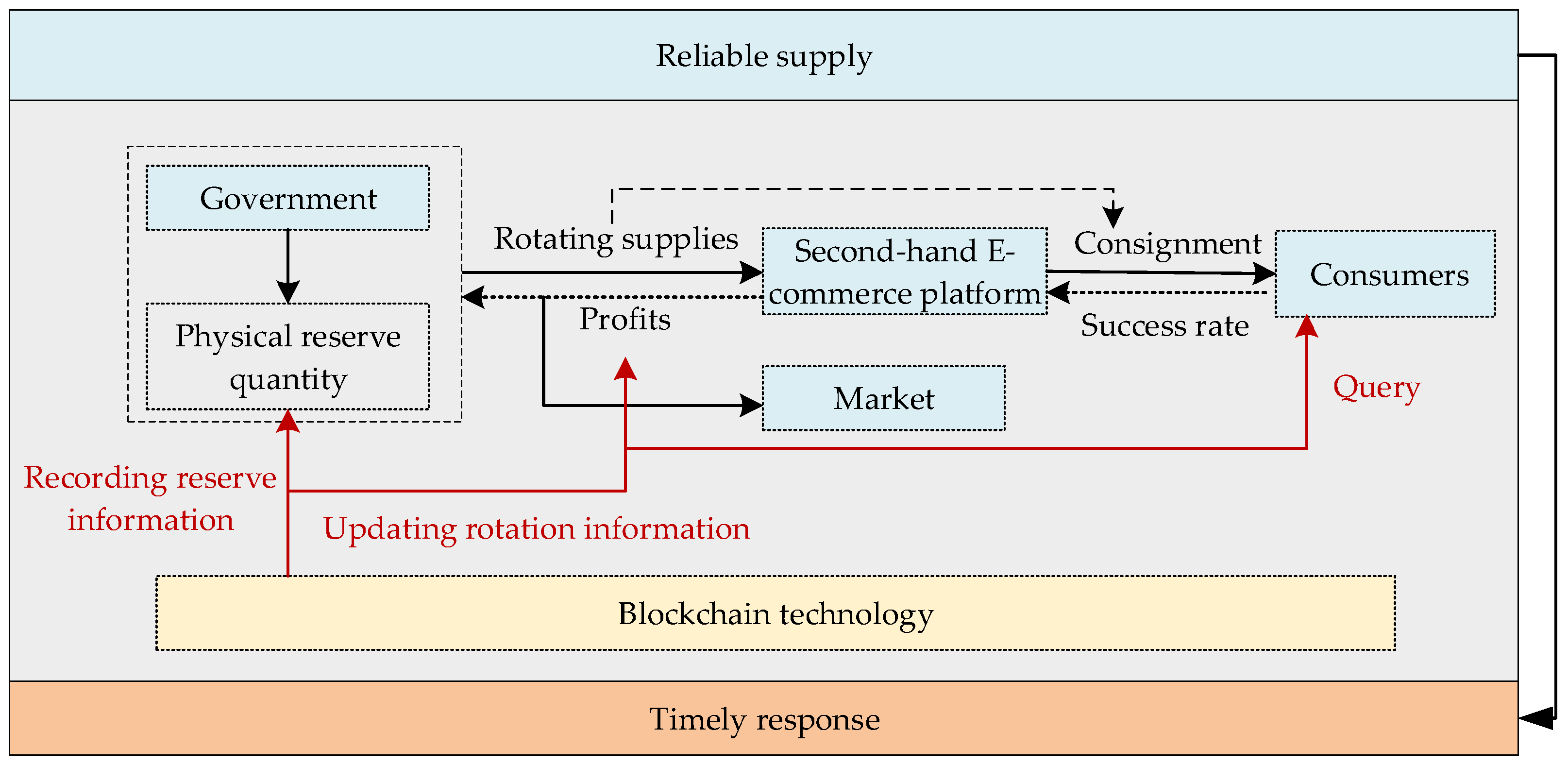
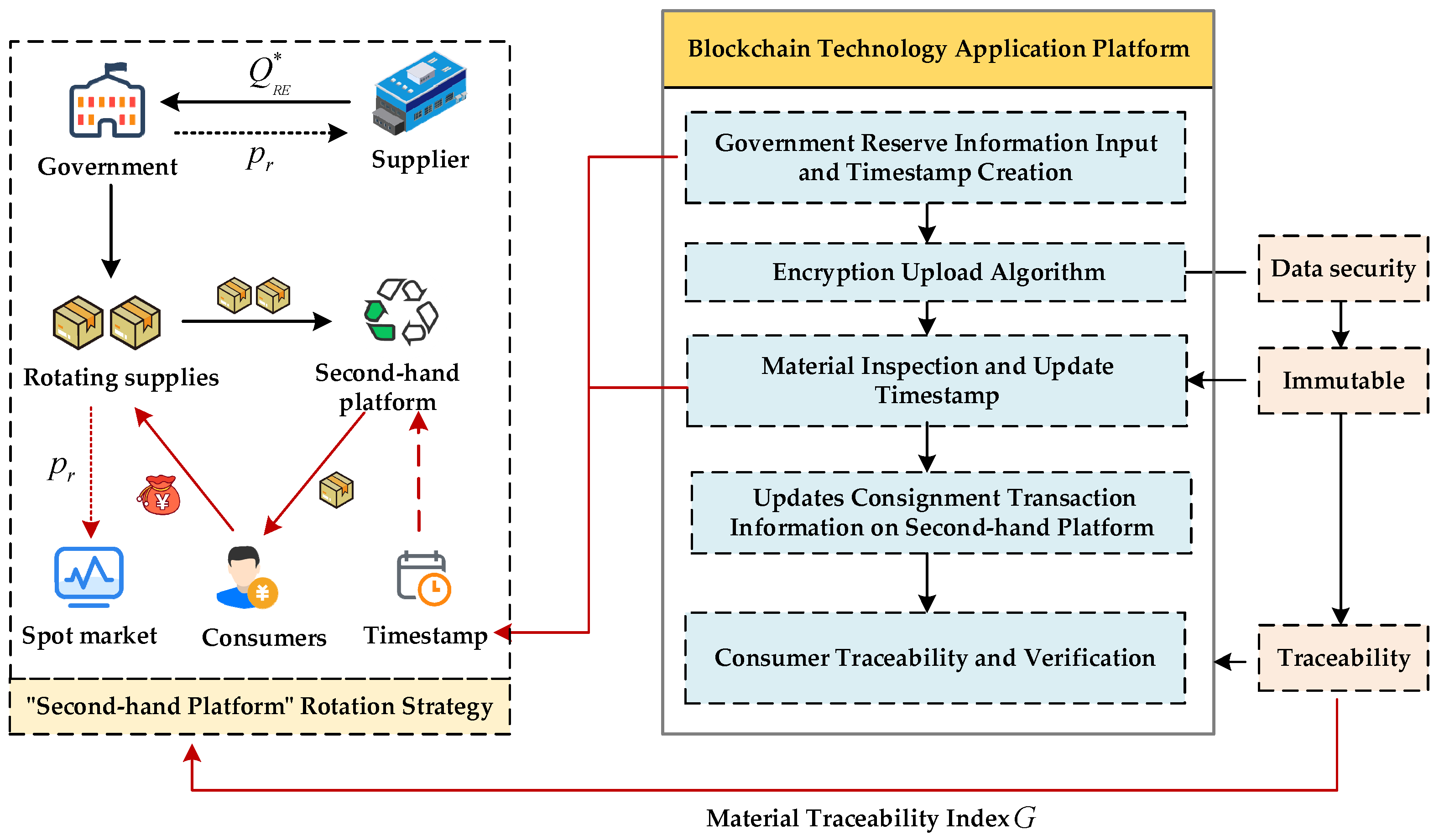
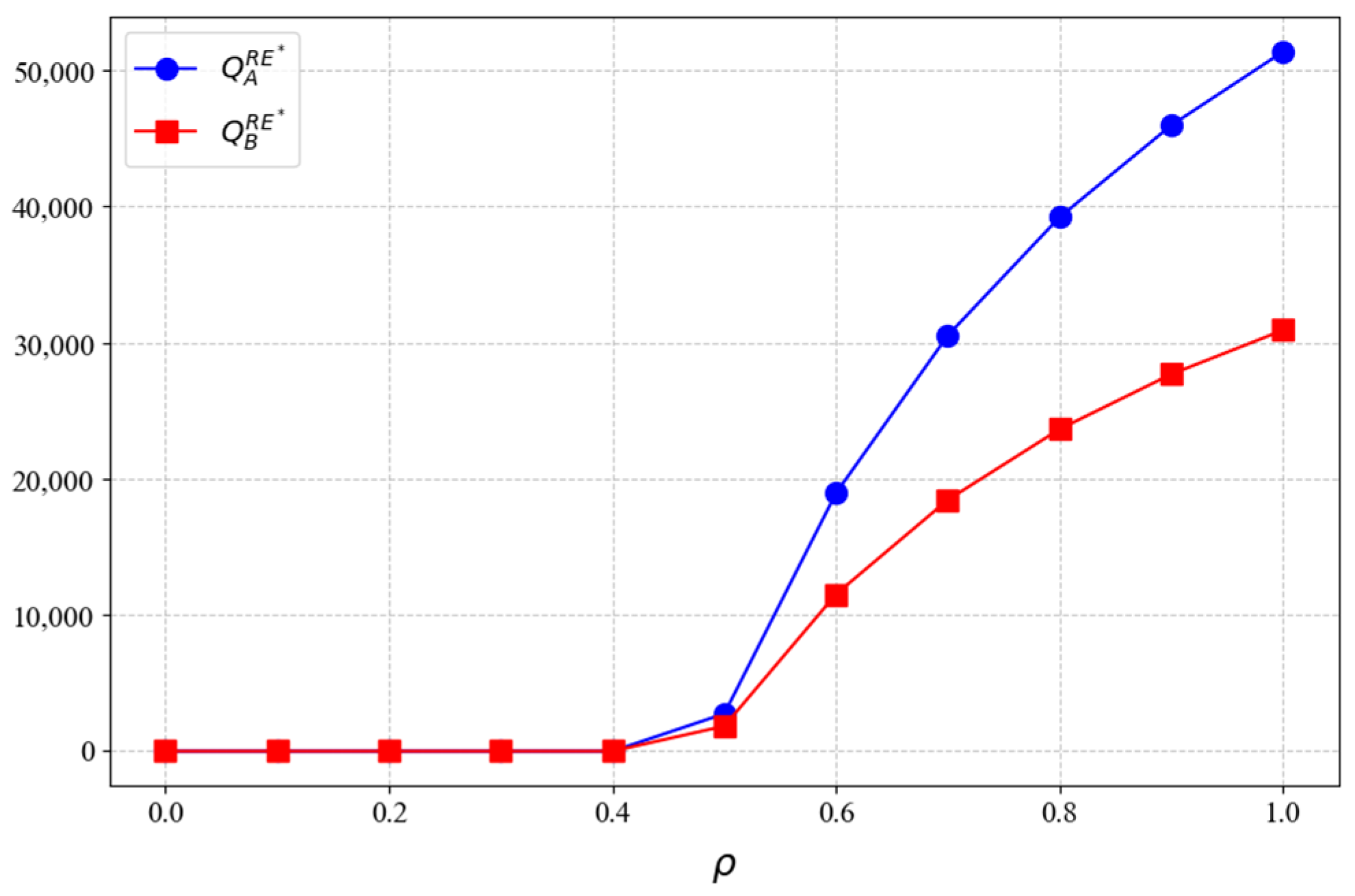
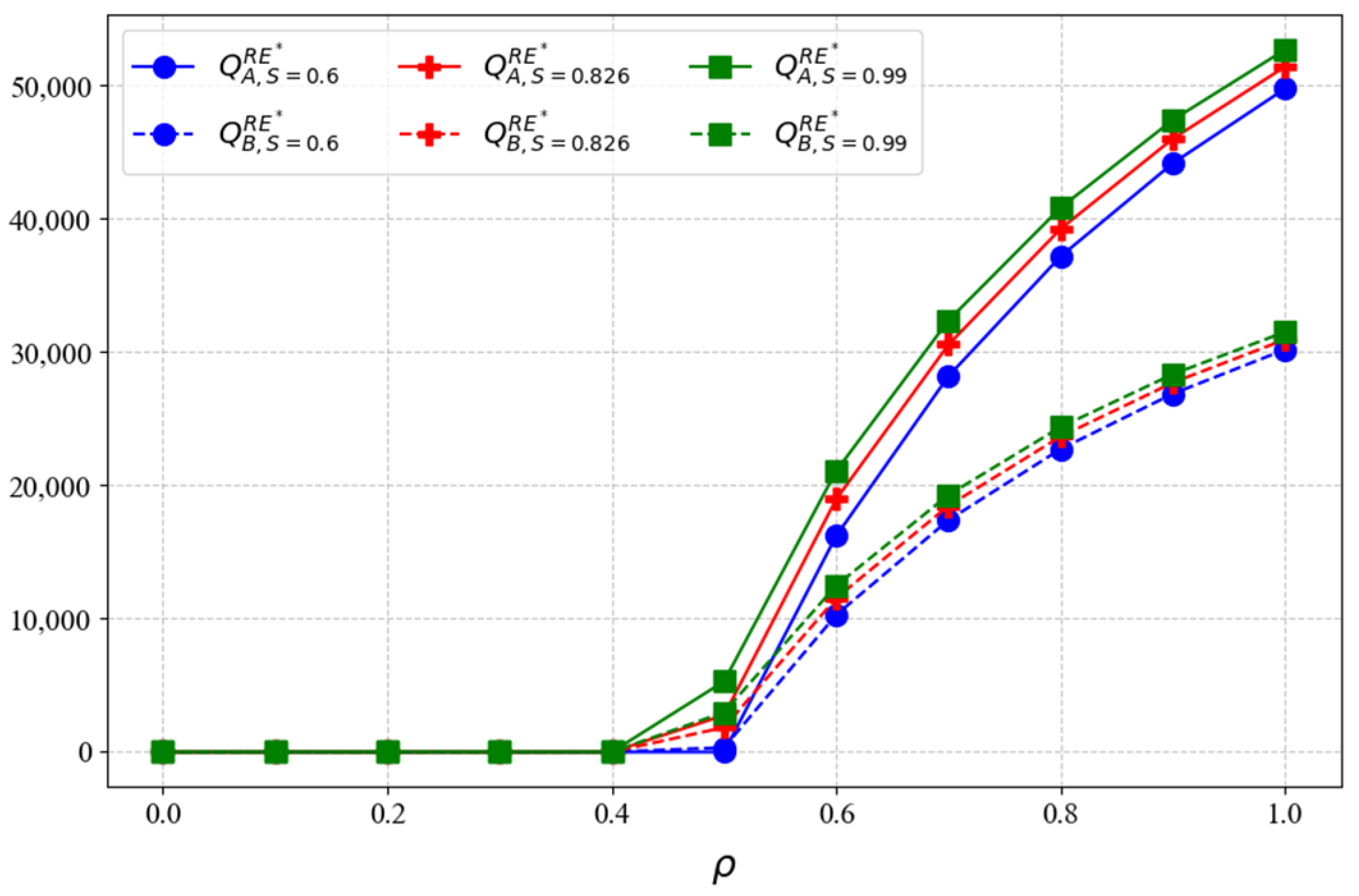
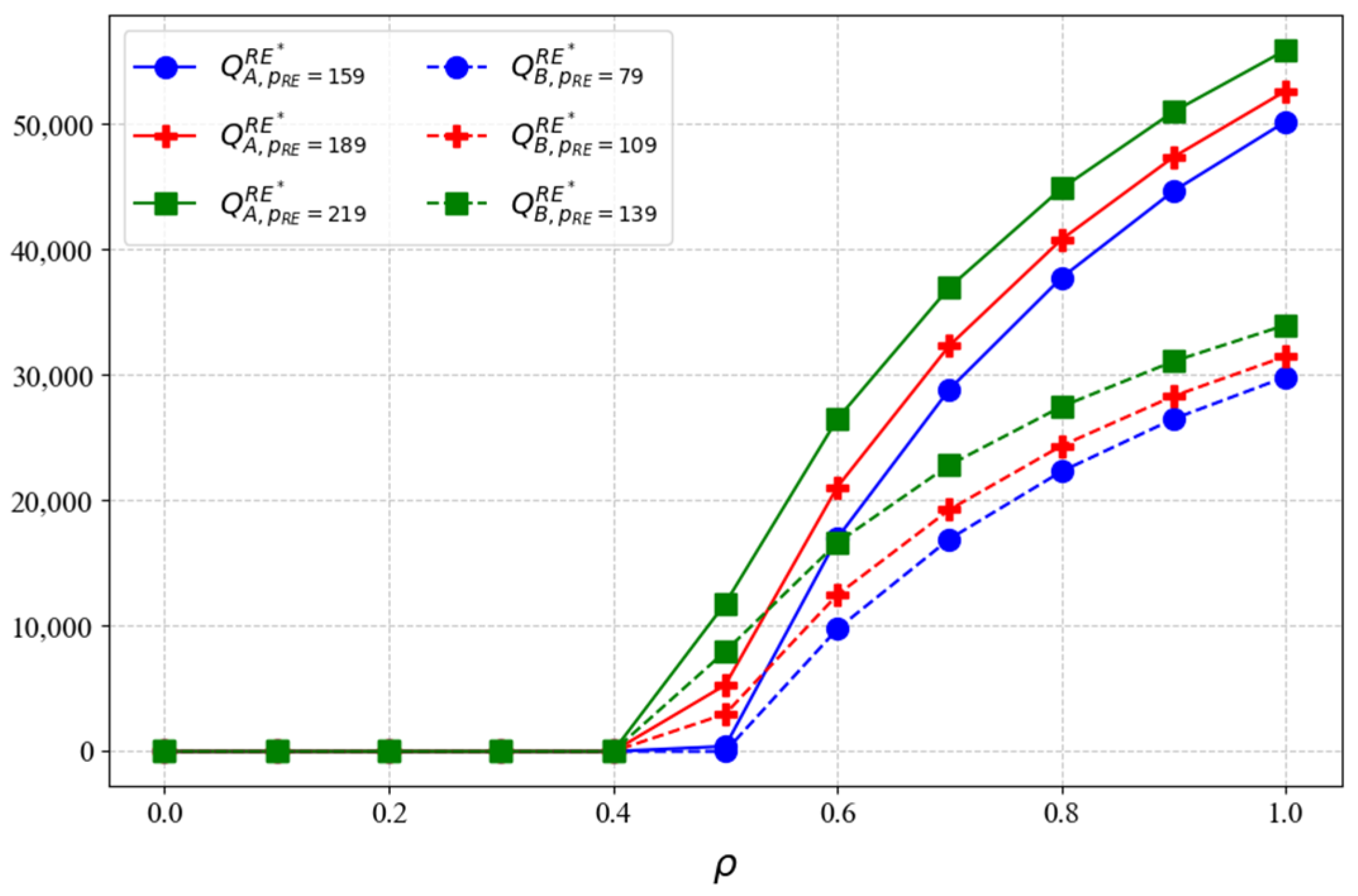

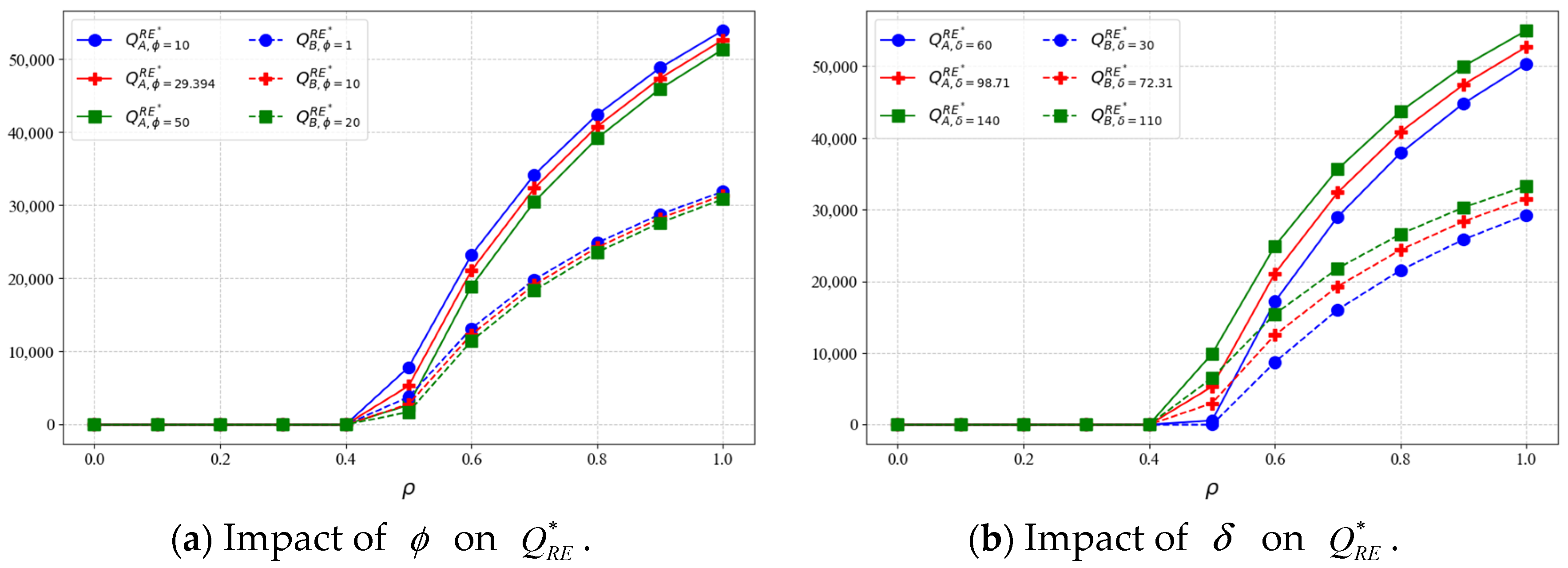


| Notation | Definition |
|---|---|
| Randomized requirements for relief supplies. Following a specific probability distribution, defining as the maximum, as the mean, and the probability density function as . denotes the cumulative distribution function, and is its inverse function. | |
| Emergency level parameters: the initial range is [0, 1], with 0 indicating not urgent and 1 indicating very urgent. | |
| Base unit loss cost of full relief supplies () for unmet needs. Unit loss cost adjusted for urgency: . | |
| Reserve difficulty parameter: the initial range is [0, 1], where 0 means easy to reserve, and 1 means very difficult to reserve. | |
| The base unit material loss or expiration cost of a totally difficult reserve stock (). : adjusted unit loss costs, weighted for reserve difficulty. | |
| Probability of a disaster occurring during the agreement cycle. | |
| Physical reserves held in advance by the government. | |
| Regular procurement prices for emergency supplies. | |
| Unit cost of production of relief supplies in an enterprise. | |
| Cost of spot purchases of relief supplies for post-disaster units. | |
| Government’s willingness to use blockchain to introduce a “second-hand platform” for consignments: . | |
| Selling price of “second-hand platform” goods. | |
| Unit cost of consigning relief supplies on second-hand platforms introducing blockchain technology. | |
| The platform’s average success rate in previous selling cycles, in [0, 1]. | |
| Item traceability index, between 0 (completely untraceable) and 1 (completely traceable), with 0.5 equal to the neutral point. | |
| Adjustment factor to quantify the impact of blockchain technology’s enhanced supplies’ traceability on the success rate of the sale, . | |
| Success rate of selling, , . | |
| Unsold salvage value. | |
| Second-hand E-commerce platform commission. |
| Parameters | Supply Names | Parameters | Supply Names | ||
|---|---|---|---|---|---|
| Pharmaceuticals (Packs) | Life Jackets (Pieces) | Pharmaceuticals (Packs) | Life Jackets (Pieces) | ||
| Basic Parameters | |||||
| 29.394 | 8.304 | ||||
| 0.9871 | 0.7231 | 0.5 | 0.5 | ||
| 100 | 100 | 258 | 169 | ||
| 98.71 | 72.31 | 178 | 119 | ||
| 0.5101 | 0.7924 | 588 | 398 | ||
| 60 | 40 | ||||
| Parameters related to the consignment strategy of the ‘second-hand platform’ considering blockchain factors | |||||
| 189 | 109 | 0.826 | 0.826 | ||
| 5 | 5 | 40 | 10 | ||
| 0.7 | 0.7 | 0.05 | 0.05 | ||
| 0.8 | 0.8 | 0.867 | 0.689 | ||
| 0.6 | 0.6 | ||||
Disclaimer/Publisher’s Note: The statements, opinions and data contained in all publications are solely those of the individual author(s) and contributor(s) and not of MDPI and/or the editor(s). MDPI and/or the editor(s) disclaim responsibility for any injury to people or property resulting from any ideas, methods, instructions or products referred to in the content. |
© 2024 by the authors. Licensee MDPI, Basel, Switzerland. This article is an open access article distributed under the terms and conditions of the Creative Commons Attribution (CC BY) license (https://creativecommons.org/licenses/by/4.0/).
Share and Cite
Ju, Y.; Wang, Y.; Yang, J.; Feng, Y.; Ren, Y. Optimizing Reserve Decisions in Relief Supply Chains with a Blockchain-Supported Second-Hand E-Commerce Platform. J. Theor. Appl. Electron. Commer. Res. 2024, 19, 1869-1892. https://doi.org/10.3390/jtaer19030092
Ju Y, Wang Y, Yang J, Feng Y, Ren Y. Optimizing Reserve Decisions in Relief Supply Chains with a Blockchain-Supported Second-Hand E-Commerce Platform. Journal of Theoretical and Applied Electronic Commerce Research. 2024; 19(3):1869-1892. https://doi.org/10.3390/jtaer19030092
Chicago/Turabian StyleJu, Yingjie, Yue Wang, Jianliang Yang, Yu Feng, and Yuheng Ren. 2024. "Optimizing Reserve Decisions in Relief Supply Chains with a Blockchain-Supported Second-Hand E-Commerce Platform" Journal of Theoretical and Applied Electronic Commerce Research 19, no. 3: 1869-1892. https://doi.org/10.3390/jtaer19030092





